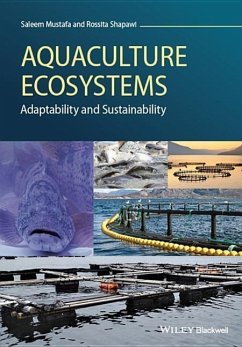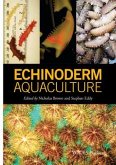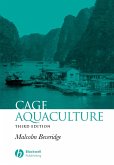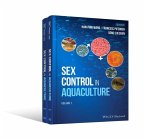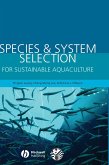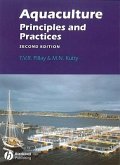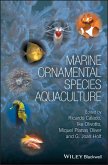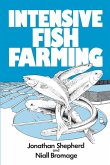Aquaculture Ecosystems
Adaptability and Sustainability
Herausgeber: Mustafa, Saleem; Shapawi, Rossita
Aquaculture Ecosystems
Adaptability and Sustainability
Herausgeber: Mustafa, Saleem; Shapawi, Rossita
- Gebundenes Buch
- Merkliste
- Auf die Merkliste
- Bewerten Bewerten
- Teilen
- Produkt teilen
- Produkterinnerung
- Produkterinnerung
Aquaculture Ecosystems focusses on incorporating elements of adaptability and sustainability in aquaculture with a view to change the course of the development of the aquaculture industry towards an ecosystem approach. The book's contents have been structured to reflect the importance of forging synergies between aquaculture and other methods of seafood production. With the stagnation of capture fisheries, the future development of the aquaculture industry is vital to provide seafood security for the ever-expanding word population. Aquaculture Ecosystems synthesises a huge wealth of…mehr
Andere Kunden interessierten sich auch für
![Echinoderm Aquaculture Echinoderm Aquaculture]() Nicholas BrownEchinoderm Aquaculture236,99 €
Nicholas BrownEchinoderm Aquaculture236,99 €![Cage Aquaculture Cage Aquaculture]() Malcolm C M BeveridgeCage Aquaculture176,99 €
Malcolm C M BeveridgeCage Aquaculture176,99 €![Sex Control in Aquaculture Sex Control in Aquaculture]() Sex Control in Aquaculture320,99 €
Sex Control in Aquaculture320,99 €![Species & System Selection for Sustainable Aquaculture Species & System Selection for Sustainable Aquaculture]() LeungSpecies & System Selection for Sustainable Aquaculture309,99 €
LeungSpecies & System Selection for Sustainable Aquaculture309,99 €![Aquaculture Aquaculture]() T V R PillayAquaculture168,99 €
T V R PillayAquaculture168,99 €![Marine Ornamental Species Aquaculture Marine Ornamental Species Aquaculture]() Marine Ornamental Species Aquaculture240,99 €
Marine Ornamental Species Aquaculture240,99 €![Intensive Fish Farming Intensive Fish Farming]() C J ShepherdIntensive Fish Farming114,99 €
C J ShepherdIntensive Fish Farming114,99 €-
-
-
Aquaculture Ecosystems focusses on incorporating elements of adaptability and sustainability in aquaculture with a view to change the course of the development of the aquaculture industry towards an ecosystem approach. The book's contents have been structured to reflect the importance of forging synergies between aquaculture and other methods of seafood production. With the stagnation of capture fisheries, the future development of the aquaculture industry is vital to provide seafood security for the ever-expanding word population. Aquaculture Ecosystems synthesises a huge wealth of information on current methods in aquaculture, drawing on best practice from established systems, and identifying areas to be modified to facilitate a sustainable way forward. This exciting new book points to the importance of adopting new models for the development of aquaculture; models which can evolve in an environmentally-compatible way. Detailed coverage is provided of the most important issues facing the ever-growing aquaculture industry, including the biology and behavior of aquatic animals and their selection for use in aquaculture systems, integrated multi-trophic aquaculture, nutrient inputs and pollution, biofouling, blue carbon stocks in coastal aquaculture, climate change adaptations, and knowledge management in aquaculture. Written by many internationally-recognised experts from around the globe and including new topics that have not been covered in this way in other aquaculture books, Aquaculture Ecosystems is an essential purchase for all those involved in the science and practice of aquaculture, in aquaculture policy development, planning, and the increasingly-important global aquaculture trade and economy. All universities and research establishments where biological sciences, aquaculture, fisheries, environmental sciences, and economics are studied and taught should have copies of this landmark book on their shelves. About the Editors Saleem Mustafa and Rossita Shapawi are based at the Borneo Marine Research Institute, Universiti Malaysia Sabah, Sabah, Malaysia. Also available from Wiley Blackwell Aquaculture, Resource Use and the Environment C Boyd & A McNevin 978-0-470-95919-0 Aquaculture Nutrition: Gut Health, Prebiotics and Probiotics D Merrifield & E Ringo 978-0-470-67271-6 Journal of the World Aquaculture Society Published bi-monthly Print ISSN: 0893-8849 Online ISSN: 1749-7345
Hinweis: Dieser Artikel kann nur an eine deutsche Lieferadresse ausgeliefert werden.
Hinweis: Dieser Artikel kann nur an eine deutsche Lieferadresse ausgeliefert werden.
Produktdetails
- Produktdetails
- Verlag: Wiley
- Seitenzahl: 400
- Erscheinungstermin: 12. Oktober 2015
- Englisch
- Abmessung: 246mm x 170mm x 23mm
- Gewicht: 839g
- ISBN-13: 9781118778548
- ISBN-10: 1118778545
- Artikelnr.: 42054997
- Herstellerkennzeichnung
- Libri GmbH
- Europaallee 1
- 36244 Bad Hersfeld
- gpsr@libri.de
- Verlag: Wiley
- Seitenzahl: 400
- Erscheinungstermin: 12. Oktober 2015
- Englisch
- Abmessung: 246mm x 170mm x 23mm
- Gewicht: 839g
- ISBN-13: 9781118778548
- ISBN-10: 1118778545
- Artikelnr.: 42054997
- Herstellerkennzeichnung
- Libri GmbH
- Europaallee 1
- 36244 Bad Hersfeld
- gpsr@libri.de
About the Editors Saleem Mustafa and Rossita Shapawi are based at the Borneo Marine Research Institute, Universiti Malaysia Sabah, Sabah, Malaysia.
Contributors xi
Preface xiii
1 Sustainability of seafood production - challenges and the way forward 1
Saleem Mustafa
1.1 Sustainability issues and concerns 1
1.2 The emergence of aquaculture 4
1.2.1 Selecting culture sites 6
1.2.2 Effects of climate change 9
1.2.3 Impact of aquaculture on climate change 15
1.2.4 Adaptation to climate change 17
1.3 Biotechnology intervention 22
1.4 Ecological fisheries-ecological aquaculture synergy 29
2 Biology of aquaculture animals - learning from nature to manage culture
37
Rossita Shapawi and Sitti Raehanah M. Shaleh
2.1 The aquatic ecosystems 37
2.2 Attributes of aquatic animals for production efficiency 41
2.3 Biological characteristics 42
2.4 Diversity and general organization 49
2.4.1 Molluscs 49
2.4.2 Echinoderms 52
2.4.3 Crustaceans 54
2.4.4 Fish 56
2.5 Selection of species for culture 65
2.5.1 Market demand 65
2.5.2 Tolerance to crowding 65
2.5.3 Feeding habits and nutritional requirements 66
2.5.4 Resistance to environmental variations 66
2.5.5 Disease resistance 66
3 Fish behaviour and aquaculture 68
Gunzo Kawamura, Teodora U. Bagarinao and Lim Leong Seng
3.1 Introduction 68
3.2 Sensory systems and functions 70
3.2.1 Vision 70
3.2.2 Photopic and scotopic vision 70
3.2.3 Ultraviolet vision 71
3.2.4 Colour vision 72
3.3 Photoreception by the pineal organ 72
3.3.1 Chemoreception by the olfactory organ 74
3.3.2 Chemoreception by taste buds 75
3.3.3 Mechanoreception by the lateral line organ 75
3.3.4 Mechanoreception by the inner ear 77
3.4 Ontogeny of the sense organs in fish larvae 77
3.5 Effect of colour on fish larvae and juveniles in tanks and cages 80
3.6 Preference of fish for colour of prey or feed 89
3.7 Effect of turbidity on fish feeding 90
3.8 Food search, taste preference and feed stimulants 91
3.9 Prey preference of captive tuna 92
3.10 Net collisions of juvenile Pacific bluefin tuna in cages 93
3.11 Predator attacks and escape of farmed fish from cages 94
3.12 Spawning of broodstocks in cages 95
3.13 Effect of cage design and materials on fish 96
3.14 Effect of cage aquaculture on wild fish 98
3.15 Stress factors for fish sensory systems 99
3.15.1 Total dissolved gas supersaturation and exophthalmia 99
3.15.2 Betanodavirus infections or viral nervous necrosis (VNN) 99
3.15.3 Parasite infections 100
3.15.4 Chemotherapeutants 101
3.15.5 Acidification of natural waters 102
3.15.6 Underwater noise 103
3.15.7 Crowding or high stocking density 105
3.16 Behavioural signs of stress in captive fish 106
4 Biofouling challenge and management methods in marine aquaculture 107
John Madin and Chong Ving Ching
4.1 Introduction 107
4.2 Vulnerability of a floating cage to biofouling, 113
4.3 Community structure and colonization of biofouling organisms, 118
4.3.1 Diversity of macrofouling assemblages, 118
4.3.2 Depth distribution of sessile macrofouling, 123
4.3.3 Colonization dynamics and succession of macrofouling organisms, 124
4.3.4 Biofouling development and occlusion rates of net mesh size, 126
4.4 Factors affecting biofouling assemblages, 127
4.4.1 Effect of season, 127
4.4.2 Effect of rearing fish, 131
4.4.3 Effect of water flow rates, 132
4.5 Biofouling prevention and control, 134
4.5.1 Siting, design and arrangement of cage units, 134
4.5.2 Rearing season, 135
4.5.3 Biological control of biofouling organisms, 135
4.5.4 Control of biofouling enhancer, 137
4.5.5 Biofouling control with non?]toxic material, 137
4.6 Future research on biofouling, 138
5 Aquaculture, coastal pollution and the environment, 139
Nicholas Kathijotes, Lubna Alam and Artemis Kontou
5.1 Introduction, 140
5.1.1 Nutrient release and potential pollution, 141
5.2 Practices in developing countries, 142
5.2.1 Aquaculture in developing countries, 143
5.3 The Cyprus nutrient situation, 154
5.3.1 Urban waste water and storm water, 154
5.3.2 Industry, 155
5.3.3 Aquaculture, 156
5.3.4 Agricultural run?]off, 156
5.3.5 Climate change - fisheries, aquaculture and the environment (adapted
from CYPADAPT 2014), 157
5.4 Mitigation and control, 161
5.5 Conclusions, 163
6 Integrated multitrophic aquaculture, 164
Abentin Estim
6.1 Introduction, 164
6.2 Biofiltration in IMTA, 167
6.3 Aquaponics, 175
6.4 Recirculating system, 177
7 Significance of blue carbon in ecological aquaculture in the context of
interrelated issues: A case study of Costa Rica, 182
Marco Sepúlveda?]Machado and Bernardo Aguilar?]González
7.1 Introduction, 183
7.2 Ecosystem services and blue carbon habitats, 185
7.3 Mangroves - ecosystem services, 186
7.3.1 Provision goods and services, 187
7.3.2 Supporting services, 189
7.3.3 Regulating services, 191
7.3.4 The monetary value of mangrove ecosystem services, 193
7.4 Trends conditioning the state of mangroves, 193
7.4.1 Pressures, 193
7.5 Blue carbon financial and institutional alternatives to command and
control policies 200
7.5.1 Blue carbon and aquaculture 201
7.6 Costa Rica: blue carbon potential and institutional profile 205
7.6.1 International regulatory framework 206
7.6.2 National regulatory framework 207
7.6.3 Policy development 209
7.6.4 Constraints and opportunities for blue carbon projects 213
7.7 Market and fund?]based mechanisms for mangrove rehabilitation and
conservation 215
7.7.1 The Clean Development Mechanism 215
7.7.2 Mangrove conservation via REDD+ 217
7.7.3 Nationally appropriate mitigation actions: mangroves and beyond 220
7.8 Community?]based conservation of mangrove ecosystems as an
institutional and financial alternative 221
7.8.1 The situation of Central America in general and Costa Rica in
specific: evolution toward relating community?]based mangrove conservation
and sustainable productive activities 222
7.8.2 Community?]based mangrove conservation options and sustainable
productive activities under REDD+ 225
7.9 Current events in Costa Rican climate change policies 227
7.9.1 The Terraba?]Sierpe National Wetland in the REDD+ national strategy
227
7.9.2 The new voluntary market opportunities of the carbon board and ban
CO2 227
7.10 A hybrid pioneer experience from the field: the community blue carbon
programme promoted by Fundación Neotrópica 228
7.10.1 Developing the building blocks: ECOTICOS and Mangle?]Benin 228
7.10.2 New project support and private sector participation 232
7.10.3 Linking the community conservation model with productive activities:
ecological aquaculture and tourism 234
7.11 Blue carbon and aquaculture - fine tuning the institutional setting
and scientific methods 236
7.11.1 Identify key ecosystems and their potential driver of degradation
237
7.11.2 Address institutional and legislative inefficiencies 238
7.11.3 Promote collaboration between academic, governmental and social
organizations 239
7.11.4 Integrate conservation and development policies and measures with
alternative institutional mechanisms 240
7.12 Conclusions 241
8 Implications of global climate change and aquaculture on blue carbon
sequestration and storage: Submerged aquatic ecosystems 243
John Barry Gallagher
8.1 Introduction 244
8.2 Seagrasses and macroalgae 247
8.3 Conceptual models 247
8.3.1 Macroalgal ecosystem attractor 250
8.3.2 Microalgal ecosystem attractor 252
8.3.3 Seagrass ecosystem attractor 252
8.4 Net ecosystem carbon balance (NECB): inputs, outputs, and storage terms
253
8.4.1 Element stoichiometry theory: partitioning the NECB 256
8.5 Blue carbon model parameters 258
8.5.1 Low frequency climatic parameter changes 260
8.6 Climate change effects on the community's blue carbon sequestration and
storage 261
8.6.1 Sea level change 263
8.6.2 Storm and flood frequency 263
8.6.3 Changes in water quality: nitrogen, pH, inorganic carbon, and
temperature 264
8.6.4 Effects of climate change at the ecosystem level 266
8.7 The effects of aquaculture on blue carbon sequestration and storage 268
8.7.1 Shellfish aquaculture 269
8.7.2 Finfish aquaculture 271
8.7.3 Seaweed aquaculture 274
8.8 Gaps in current knowledge 276
8.9 Conclusions 277
9 Knowledge management in modern aquaculture 281
Faizan Hasan Mustafa, Shigeharu Senoo and Awangku Hassanal Bahar Pengiran
Bagul
9.1 Introduction 281
9.2 Knowledge management ecosystem in aquaculture 285
9.3 Knowledge management systems and tools 291
9.3.1 Brainstorming 291
9.3.2 Knowledge forum 292
9.3.3 Document management and data bases 292
9.3.4 Web?]based platforms and social networking services 294
9.3.5 Knowledge blogs 297
9.4 Learning and capturing ideas with modern tools 298
9.4.1 Knowledge café 298
9.4.2 Peer Assist 299
9.4.3 Voice and VOIP 300
9.4.4 Artificial intelligent systems 301
9.4.5 Robotics in aquaculture 305
9.4.6 Knowledge clusters 306
9.5 Knowledge management strategies for aquaculture 308
9.5.1 Role of universities in generating knowledge and critical mass 308
9.5.2 Coproduction of knowledge 310
9.6 Knowledge management for aquaculture incubator centres 312
9.6.1 Requirements for aquaculture incubator centres 313
9.7 Knowledge management for policy making, planning and management 315
9.8 Conclusions 318
References 319
Index 372
Preface xiii
1 Sustainability of seafood production - challenges and the way forward 1
Saleem Mustafa
1.1 Sustainability issues and concerns 1
1.2 The emergence of aquaculture 4
1.2.1 Selecting culture sites 6
1.2.2 Effects of climate change 9
1.2.3 Impact of aquaculture on climate change 15
1.2.4 Adaptation to climate change 17
1.3 Biotechnology intervention 22
1.4 Ecological fisheries-ecological aquaculture synergy 29
2 Biology of aquaculture animals - learning from nature to manage culture
37
Rossita Shapawi and Sitti Raehanah M. Shaleh
2.1 The aquatic ecosystems 37
2.2 Attributes of aquatic animals for production efficiency 41
2.3 Biological characteristics 42
2.4 Diversity and general organization 49
2.4.1 Molluscs 49
2.4.2 Echinoderms 52
2.4.3 Crustaceans 54
2.4.4 Fish 56
2.5 Selection of species for culture 65
2.5.1 Market demand 65
2.5.2 Tolerance to crowding 65
2.5.3 Feeding habits and nutritional requirements 66
2.5.4 Resistance to environmental variations 66
2.5.5 Disease resistance 66
3 Fish behaviour and aquaculture 68
Gunzo Kawamura, Teodora U. Bagarinao and Lim Leong Seng
3.1 Introduction 68
3.2 Sensory systems and functions 70
3.2.1 Vision 70
3.2.2 Photopic and scotopic vision 70
3.2.3 Ultraviolet vision 71
3.2.4 Colour vision 72
3.3 Photoreception by the pineal organ 72
3.3.1 Chemoreception by the olfactory organ 74
3.3.2 Chemoreception by taste buds 75
3.3.3 Mechanoreception by the lateral line organ 75
3.3.4 Mechanoreception by the inner ear 77
3.4 Ontogeny of the sense organs in fish larvae 77
3.5 Effect of colour on fish larvae and juveniles in tanks and cages 80
3.6 Preference of fish for colour of prey or feed 89
3.7 Effect of turbidity on fish feeding 90
3.8 Food search, taste preference and feed stimulants 91
3.9 Prey preference of captive tuna 92
3.10 Net collisions of juvenile Pacific bluefin tuna in cages 93
3.11 Predator attacks and escape of farmed fish from cages 94
3.12 Spawning of broodstocks in cages 95
3.13 Effect of cage design and materials on fish 96
3.14 Effect of cage aquaculture on wild fish 98
3.15 Stress factors for fish sensory systems 99
3.15.1 Total dissolved gas supersaturation and exophthalmia 99
3.15.2 Betanodavirus infections or viral nervous necrosis (VNN) 99
3.15.3 Parasite infections 100
3.15.4 Chemotherapeutants 101
3.15.5 Acidification of natural waters 102
3.15.6 Underwater noise 103
3.15.7 Crowding or high stocking density 105
3.16 Behavioural signs of stress in captive fish 106
4 Biofouling challenge and management methods in marine aquaculture 107
John Madin and Chong Ving Ching
4.1 Introduction 107
4.2 Vulnerability of a floating cage to biofouling, 113
4.3 Community structure and colonization of biofouling organisms, 118
4.3.1 Diversity of macrofouling assemblages, 118
4.3.2 Depth distribution of sessile macrofouling, 123
4.3.3 Colonization dynamics and succession of macrofouling organisms, 124
4.3.4 Biofouling development and occlusion rates of net mesh size, 126
4.4 Factors affecting biofouling assemblages, 127
4.4.1 Effect of season, 127
4.4.2 Effect of rearing fish, 131
4.4.3 Effect of water flow rates, 132
4.5 Biofouling prevention and control, 134
4.5.1 Siting, design and arrangement of cage units, 134
4.5.2 Rearing season, 135
4.5.3 Biological control of biofouling organisms, 135
4.5.4 Control of biofouling enhancer, 137
4.5.5 Biofouling control with non?]toxic material, 137
4.6 Future research on biofouling, 138
5 Aquaculture, coastal pollution and the environment, 139
Nicholas Kathijotes, Lubna Alam and Artemis Kontou
5.1 Introduction, 140
5.1.1 Nutrient release and potential pollution, 141
5.2 Practices in developing countries, 142
5.2.1 Aquaculture in developing countries, 143
5.3 The Cyprus nutrient situation, 154
5.3.1 Urban waste water and storm water, 154
5.3.2 Industry, 155
5.3.3 Aquaculture, 156
5.3.4 Agricultural run?]off, 156
5.3.5 Climate change - fisheries, aquaculture and the environment (adapted
from CYPADAPT 2014), 157
5.4 Mitigation and control, 161
5.5 Conclusions, 163
6 Integrated multitrophic aquaculture, 164
Abentin Estim
6.1 Introduction, 164
6.2 Biofiltration in IMTA, 167
6.3 Aquaponics, 175
6.4 Recirculating system, 177
7 Significance of blue carbon in ecological aquaculture in the context of
interrelated issues: A case study of Costa Rica, 182
Marco Sepúlveda?]Machado and Bernardo Aguilar?]González
7.1 Introduction, 183
7.2 Ecosystem services and blue carbon habitats, 185
7.3 Mangroves - ecosystem services, 186
7.3.1 Provision goods and services, 187
7.3.2 Supporting services, 189
7.3.3 Regulating services, 191
7.3.4 The monetary value of mangrove ecosystem services, 193
7.4 Trends conditioning the state of mangroves, 193
7.4.1 Pressures, 193
7.5 Blue carbon financial and institutional alternatives to command and
control policies 200
7.5.1 Blue carbon and aquaculture 201
7.6 Costa Rica: blue carbon potential and institutional profile 205
7.6.1 International regulatory framework 206
7.6.2 National regulatory framework 207
7.6.3 Policy development 209
7.6.4 Constraints and opportunities for blue carbon projects 213
7.7 Market and fund?]based mechanisms for mangrove rehabilitation and
conservation 215
7.7.1 The Clean Development Mechanism 215
7.7.2 Mangrove conservation via REDD+ 217
7.7.3 Nationally appropriate mitigation actions: mangroves and beyond 220
7.8 Community?]based conservation of mangrove ecosystems as an
institutional and financial alternative 221
7.8.1 The situation of Central America in general and Costa Rica in
specific: evolution toward relating community?]based mangrove conservation
and sustainable productive activities 222
7.8.2 Community?]based mangrove conservation options and sustainable
productive activities under REDD+ 225
7.9 Current events in Costa Rican climate change policies 227
7.9.1 The Terraba?]Sierpe National Wetland in the REDD+ national strategy
227
7.9.2 The new voluntary market opportunities of the carbon board and ban
CO2 227
7.10 A hybrid pioneer experience from the field: the community blue carbon
programme promoted by Fundación Neotrópica 228
7.10.1 Developing the building blocks: ECOTICOS and Mangle?]Benin 228
7.10.2 New project support and private sector participation 232
7.10.3 Linking the community conservation model with productive activities:
ecological aquaculture and tourism 234
7.11 Blue carbon and aquaculture - fine tuning the institutional setting
and scientific methods 236
7.11.1 Identify key ecosystems and their potential driver of degradation
237
7.11.2 Address institutional and legislative inefficiencies 238
7.11.3 Promote collaboration between academic, governmental and social
organizations 239
7.11.4 Integrate conservation and development policies and measures with
alternative institutional mechanisms 240
7.12 Conclusions 241
8 Implications of global climate change and aquaculture on blue carbon
sequestration and storage: Submerged aquatic ecosystems 243
John Barry Gallagher
8.1 Introduction 244
8.2 Seagrasses and macroalgae 247
8.3 Conceptual models 247
8.3.1 Macroalgal ecosystem attractor 250
8.3.2 Microalgal ecosystem attractor 252
8.3.3 Seagrass ecosystem attractor 252
8.4 Net ecosystem carbon balance (NECB): inputs, outputs, and storage terms
253
8.4.1 Element stoichiometry theory: partitioning the NECB 256
8.5 Blue carbon model parameters 258
8.5.1 Low frequency climatic parameter changes 260
8.6 Climate change effects on the community's blue carbon sequestration and
storage 261
8.6.1 Sea level change 263
8.6.2 Storm and flood frequency 263
8.6.3 Changes in water quality: nitrogen, pH, inorganic carbon, and
temperature 264
8.6.4 Effects of climate change at the ecosystem level 266
8.7 The effects of aquaculture on blue carbon sequestration and storage 268
8.7.1 Shellfish aquaculture 269
8.7.2 Finfish aquaculture 271
8.7.3 Seaweed aquaculture 274
8.8 Gaps in current knowledge 276
8.9 Conclusions 277
9 Knowledge management in modern aquaculture 281
Faizan Hasan Mustafa, Shigeharu Senoo and Awangku Hassanal Bahar Pengiran
Bagul
9.1 Introduction 281
9.2 Knowledge management ecosystem in aquaculture 285
9.3 Knowledge management systems and tools 291
9.3.1 Brainstorming 291
9.3.2 Knowledge forum 292
9.3.3 Document management and data bases 292
9.3.4 Web?]based platforms and social networking services 294
9.3.5 Knowledge blogs 297
9.4 Learning and capturing ideas with modern tools 298
9.4.1 Knowledge café 298
9.4.2 Peer Assist 299
9.4.3 Voice and VOIP 300
9.4.4 Artificial intelligent systems 301
9.4.5 Robotics in aquaculture 305
9.4.6 Knowledge clusters 306
9.5 Knowledge management strategies for aquaculture 308
9.5.1 Role of universities in generating knowledge and critical mass 308
9.5.2 Coproduction of knowledge 310
9.6 Knowledge management for aquaculture incubator centres 312
9.6.1 Requirements for aquaculture incubator centres 313
9.7 Knowledge management for policy making, planning and management 315
9.8 Conclusions 318
References 319
Index 372
Contributors xi
Preface xiii
1 Sustainability of seafood production - challenges and the way forward 1
Saleem Mustafa
1.1 Sustainability issues and concerns 1
1.2 The emergence of aquaculture 4
1.2.1 Selecting culture sites 6
1.2.2 Effects of climate change 9
1.2.3 Impact of aquaculture on climate change 15
1.2.4 Adaptation to climate change 17
1.3 Biotechnology intervention 22
1.4 Ecological fisheries-ecological aquaculture synergy 29
2 Biology of aquaculture animals - learning from nature to manage culture
37
Rossita Shapawi and Sitti Raehanah M. Shaleh
2.1 The aquatic ecosystems 37
2.2 Attributes of aquatic animals for production efficiency 41
2.3 Biological characteristics 42
2.4 Diversity and general organization 49
2.4.1 Molluscs 49
2.4.2 Echinoderms 52
2.4.3 Crustaceans 54
2.4.4 Fish 56
2.5 Selection of species for culture 65
2.5.1 Market demand 65
2.5.2 Tolerance to crowding 65
2.5.3 Feeding habits and nutritional requirements 66
2.5.4 Resistance to environmental variations 66
2.5.5 Disease resistance 66
3 Fish behaviour and aquaculture 68
Gunzo Kawamura, Teodora U. Bagarinao and Lim Leong Seng
3.1 Introduction 68
3.2 Sensory systems and functions 70
3.2.1 Vision 70
3.2.2 Photopic and scotopic vision 70
3.2.3 Ultraviolet vision 71
3.2.4 Colour vision 72
3.3 Photoreception by the pineal organ 72
3.3.1 Chemoreception by the olfactory organ 74
3.3.2 Chemoreception by taste buds 75
3.3.3 Mechanoreception by the lateral line organ 75
3.3.4 Mechanoreception by the inner ear 77
3.4 Ontogeny of the sense organs in fish larvae 77
3.5 Effect of colour on fish larvae and juveniles in tanks and cages 80
3.6 Preference of fish for colour of prey or feed 89
3.7 Effect of turbidity on fish feeding 90
3.8 Food search, taste preference and feed stimulants 91
3.9 Prey preference of captive tuna 92
3.10 Net collisions of juvenile Pacific bluefin tuna in cages 93
3.11 Predator attacks and escape of farmed fish from cages 94
3.12 Spawning of broodstocks in cages 95
3.13 Effect of cage design and materials on fish 96
3.14 Effect of cage aquaculture on wild fish 98
3.15 Stress factors for fish sensory systems 99
3.15.1 Total dissolved gas supersaturation and exophthalmia 99
3.15.2 Betanodavirus infections or viral nervous necrosis (VNN) 99
3.15.3 Parasite infections 100
3.15.4 Chemotherapeutants 101
3.15.5 Acidification of natural waters 102
3.15.6 Underwater noise 103
3.15.7 Crowding or high stocking density 105
3.16 Behavioural signs of stress in captive fish 106
4 Biofouling challenge and management methods in marine aquaculture 107
John Madin and Chong Ving Ching
4.1 Introduction 107
4.2 Vulnerability of a floating cage to biofouling, 113
4.3 Community structure and colonization of biofouling organisms, 118
4.3.1 Diversity of macrofouling assemblages, 118
4.3.2 Depth distribution of sessile macrofouling, 123
4.3.3 Colonization dynamics and succession of macrofouling organisms, 124
4.3.4 Biofouling development and occlusion rates of net mesh size, 126
4.4 Factors affecting biofouling assemblages, 127
4.4.1 Effect of season, 127
4.4.2 Effect of rearing fish, 131
4.4.3 Effect of water flow rates, 132
4.5 Biofouling prevention and control, 134
4.5.1 Siting, design and arrangement of cage units, 134
4.5.2 Rearing season, 135
4.5.3 Biological control of biofouling organisms, 135
4.5.4 Control of biofouling enhancer, 137
4.5.5 Biofouling control with non?]toxic material, 137
4.6 Future research on biofouling, 138
5 Aquaculture, coastal pollution and the environment, 139
Nicholas Kathijotes, Lubna Alam and Artemis Kontou
5.1 Introduction, 140
5.1.1 Nutrient release and potential pollution, 141
5.2 Practices in developing countries, 142
5.2.1 Aquaculture in developing countries, 143
5.3 The Cyprus nutrient situation, 154
5.3.1 Urban waste water and storm water, 154
5.3.2 Industry, 155
5.3.3 Aquaculture, 156
5.3.4 Agricultural run?]off, 156
5.3.5 Climate change - fisheries, aquaculture and the environment (adapted
from CYPADAPT 2014), 157
5.4 Mitigation and control, 161
5.5 Conclusions, 163
6 Integrated multitrophic aquaculture, 164
Abentin Estim
6.1 Introduction, 164
6.2 Biofiltration in IMTA, 167
6.3 Aquaponics, 175
6.4 Recirculating system, 177
7 Significance of blue carbon in ecological aquaculture in the context of
interrelated issues: A case study of Costa Rica, 182
Marco Sepúlveda?]Machado and Bernardo Aguilar?]González
7.1 Introduction, 183
7.2 Ecosystem services and blue carbon habitats, 185
7.3 Mangroves - ecosystem services, 186
7.3.1 Provision goods and services, 187
7.3.2 Supporting services, 189
7.3.3 Regulating services, 191
7.3.4 The monetary value of mangrove ecosystem services, 193
7.4 Trends conditioning the state of mangroves, 193
7.4.1 Pressures, 193
7.5 Blue carbon financial and institutional alternatives to command and
control policies 200
7.5.1 Blue carbon and aquaculture 201
7.6 Costa Rica: blue carbon potential and institutional profile 205
7.6.1 International regulatory framework 206
7.6.2 National regulatory framework 207
7.6.3 Policy development 209
7.6.4 Constraints and opportunities for blue carbon projects 213
7.7 Market and fund?]based mechanisms for mangrove rehabilitation and
conservation 215
7.7.1 The Clean Development Mechanism 215
7.7.2 Mangrove conservation via REDD+ 217
7.7.3 Nationally appropriate mitigation actions: mangroves and beyond 220
7.8 Community?]based conservation of mangrove ecosystems as an
institutional and financial alternative 221
7.8.1 The situation of Central America in general and Costa Rica in
specific: evolution toward relating community?]based mangrove conservation
and sustainable productive activities 222
7.8.2 Community?]based mangrove conservation options and sustainable
productive activities under REDD+ 225
7.9 Current events in Costa Rican climate change policies 227
7.9.1 The Terraba?]Sierpe National Wetland in the REDD+ national strategy
227
7.9.2 The new voluntary market opportunities of the carbon board and ban
CO2 227
7.10 A hybrid pioneer experience from the field: the community blue carbon
programme promoted by Fundación Neotrópica 228
7.10.1 Developing the building blocks: ECOTICOS and Mangle?]Benin 228
7.10.2 New project support and private sector participation 232
7.10.3 Linking the community conservation model with productive activities:
ecological aquaculture and tourism 234
7.11 Blue carbon and aquaculture - fine tuning the institutional setting
and scientific methods 236
7.11.1 Identify key ecosystems and their potential driver of degradation
237
7.11.2 Address institutional and legislative inefficiencies 238
7.11.3 Promote collaboration between academic, governmental and social
organizations 239
7.11.4 Integrate conservation and development policies and measures with
alternative institutional mechanisms 240
7.12 Conclusions 241
8 Implications of global climate change and aquaculture on blue carbon
sequestration and storage: Submerged aquatic ecosystems 243
John Barry Gallagher
8.1 Introduction 244
8.2 Seagrasses and macroalgae 247
8.3 Conceptual models 247
8.3.1 Macroalgal ecosystem attractor 250
8.3.2 Microalgal ecosystem attractor 252
8.3.3 Seagrass ecosystem attractor 252
8.4 Net ecosystem carbon balance (NECB): inputs, outputs, and storage terms
253
8.4.1 Element stoichiometry theory: partitioning the NECB 256
8.5 Blue carbon model parameters 258
8.5.1 Low frequency climatic parameter changes 260
8.6 Climate change effects on the community's blue carbon sequestration and
storage 261
8.6.1 Sea level change 263
8.6.2 Storm and flood frequency 263
8.6.3 Changes in water quality: nitrogen, pH, inorganic carbon, and
temperature 264
8.6.4 Effects of climate change at the ecosystem level 266
8.7 The effects of aquaculture on blue carbon sequestration and storage 268
8.7.1 Shellfish aquaculture 269
8.7.2 Finfish aquaculture 271
8.7.3 Seaweed aquaculture 274
8.8 Gaps in current knowledge 276
8.9 Conclusions 277
9 Knowledge management in modern aquaculture 281
Faizan Hasan Mustafa, Shigeharu Senoo and Awangku Hassanal Bahar Pengiran
Bagul
9.1 Introduction 281
9.2 Knowledge management ecosystem in aquaculture 285
9.3 Knowledge management systems and tools 291
9.3.1 Brainstorming 291
9.3.2 Knowledge forum 292
9.3.3 Document management and data bases 292
9.3.4 Web?]based platforms and social networking services 294
9.3.5 Knowledge blogs 297
9.4 Learning and capturing ideas with modern tools 298
9.4.1 Knowledge café 298
9.4.2 Peer Assist 299
9.4.3 Voice and VOIP 300
9.4.4 Artificial intelligent systems 301
9.4.5 Robotics in aquaculture 305
9.4.6 Knowledge clusters 306
9.5 Knowledge management strategies for aquaculture 308
9.5.1 Role of universities in generating knowledge and critical mass 308
9.5.2 Coproduction of knowledge 310
9.6 Knowledge management for aquaculture incubator centres 312
9.6.1 Requirements for aquaculture incubator centres 313
9.7 Knowledge management for policy making, planning and management 315
9.8 Conclusions 318
References 319
Index 372
Preface xiii
1 Sustainability of seafood production - challenges and the way forward 1
Saleem Mustafa
1.1 Sustainability issues and concerns 1
1.2 The emergence of aquaculture 4
1.2.1 Selecting culture sites 6
1.2.2 Effects of climate change 9
1.2.3 Impact of aquaculture on climate change 15
1.2.4 Adaptation to climate change 17
1.3 Biotechnology intervention 22
1.4 Ecological fisheries-ecological aquaculture synergy 29
2 Biology of aquaculture animals - learning from nature to manage culture
37
Rossita Shapawi and Sitti Raehanah M. Shaleh
2.1 The aquatic ecosystems 37
2.2 Attributes of aquatic animals for production efficiency 41
2.3 Biological characteristics 42
2.4 Diversity and general organization 49
2.4.1 Molluscs 49
2.4.2 Echinoderms 52
2.4.3 Crustaceans 54
2.4.4 Fish 56
2.5 Selection of species for culture 65
2.5.1 Market demand 65
2.5.2 Tolerance to crowding 65
2.5.3 Feeding habits and nutritional requirements 66
2.5.4 Resistance to environmental variations 66
2.5.5 Disease resistance 66
3 Fish behaviour and aquaculture 68
Gunzo Kawamura, Teodora U. Bagarinao and Lim Leong Seng
3.1 Introduction 68
3.2 Sensory systems and functions 70
3.2.1 Vision 70
3.2.2 Photopic and scotopic vision 70
3.2.3 Ultraviolet vision 71
3.2.4 Colour vision 72
3.3 Photoreception by the pineal organ 72
3.3.1 Chemoreception by the olfactory organ 74
3.3.2 Chemoreception by taste buds 75
3.3.3 Mechanoreception by the lateral line organ 75
3.3.4 Mechanoreception by the inner ear 77
3.4 Ontogeny of the sense organs in fish larvae 77
3.5 Effect of colour on fish larvae and juveniles in tanks and cages 80
3.6 Preference of fish for colour of prey or feed 89
3.7 Effect of turbidity on fish feeding 90
3.8 Food search, taste preference and feed stimulants 91
3.9 Prey preference of captive tuna 92
3.10 Net collisions of juvenile Pacific bluefin tuna in cages 93
3.11 Predator attacks and escape of farmed fish from cages 94
3.12 Spawning of broodstocks in cages 95
3.13 Effect of cage design and materials on fish 96
3.14 Effect of cage aquaculture on wild fish 98
3.15 Stress factors for fish sensory systems 99
3.15.1 Total dissolved gas supersaturation and exophthalmia 99
3.15.2 Betanodavirus infections or viral nervous necrosis (VNN) 99
3.15.3 Parasite infections 100
3.15.4 Chemotherapeutants 101
3.15.5 Acidification of natural waters 102
3.15.6 Underwater noise 103
3.15.7 Crowding or high stocking density 105
3.16 Behavioural signs of stress in captive fish 106
4 Biofouling challenge and management methods in marine aquaculture 107
John Madin and Chong Ving Ching
4.1 Introduction 107
4.2 Vulnerability of a floating cage to biofouling, 113
4.3 Community structure and colonization of biofouling organisms, 118
4.3.1 Diversity of macrofouling assemblages, 118
4.3.2 Depth distribution of sessile macrofouling, 123
4.3.3 Colonization dynamics and succession of macrofouling organisms, 124
4.3.4 Biofouling development and occlusion rates of net mesh size, 126
4.4 Factors affecting biofouling assemblages, 127
4.4.1 Effect of season, 127
4.4.2 Effect of rearing fish, 131
4.4.3 Effect of water flow rates, 132
4.5 Biofouling prevention and control, 134
4.5.1 Siting, design and arrangement of cage units, 134
4.5.2 Rearing season, 135
4.5.3 Biological control of biofouling organisms, 135
4.5.4 Control of biofouling enhancer, 137
4.5.5 Biofouling control with non?]toxic material, 137
4.6 Future research on biofouling, 138
5 Aquaculture, coastal pollution and the environment, 139
Nicholas Kathijotes, Lubna Alam and Artemis Kontou
5.1 Introduction, 140
5.1.1 Nutrient release and potential pollution, 141
5.2 Practices in developing countries, 142
5.2.1 Aquaculture in developing countries, 143
5.3 The Cyprus nutrient situation, 154
5.3.1 Urban waste water and storm water, 154
5.3.2 Industry, 155
5.3.3 Aquaculture, 156
5.3.4 Agricultural run?]off, 156
5.3.5 Climate change - fisheries, aquaculture and the environment (adapted
from CYPADAPT 2014), 157
5.4 Mitigation and control, 161
5.5 Conclusions, 163
6 Integrated multitrophic aquaculture, 164
Abentin Estim
6.1 Introduction, 164
6.2 Biofiltration in IMTA, 167
6.3 Aquaponics, 175
6.4 Recirculating system, 177
7 Significance of blue carbon in ecological aquaculture in the context of
interrelated issues: A case study of Costa Rica, 182
Marco Sepúlveda?]Machado and Bernardo Aguilar?]González
7.1 Introduction, 183
7.2 Ecosystem services and blue carbon habitats, 185
7.3 Mangroves - ecosystem services, 186
7.3.1 Provision goods and services, 187
7.3.2 Supporting services, 189
7.3.3 Regulating services, 191
7.3.4 The monetary value of mangrove ecosystem services, 193
7.4 Trends conditioning the state of mangroves, 193
7.4.1 Pressures, 193
7.5 Blue carbon financial and institutional alternatives to command and
control policies 200
7.5.1 Blue carbon and aquaculture 201
7.6 Costa Rica: blue carbon potential and institutional profile 205
7.6.1 International regulatory framework 206
7.6.2 National regulatory framework 207
7.6.3 Policy development 209
7.6.4 Constraints and opportunities for blue carbon projects 213
7.7 Market and fund?]based mechanisms for mangrove rehabilitation and
conservation 215
7.7.1 The Clean Development Mechanism 215
7.7.2 Mangrove conservation via REDD+ 217
7.7.3 Nationally appropriate mitigation actions: mangroves and beyond 220
7.8 Community?]based conservation of mangrove ecosystems as an
institutional and financial alternative 221
7.8.1 The situation of Central America in general and Costa Rica in
specific: evolution toward relating community?]based mangrove conservation
and sustainable productive activities 222
7.8.2 Community?]based mangrove conservation options and sustainable
productive activities under REDD+ 225
7.9 Current events in Costa Rican climate change policies 227
7.9.1 The Terraba?]Sierpe National Wetland in the REDD+ national strategy
227
7.9.2 The new voluntary market opportunities of the carbon board and ban
CO2 227
7.10 A hybrid pioneer experience from the field: the community blue carbon
programme promoted by Fundación Neotrópica 228
7.10.1 Developing the building blocks: ECOTICOS and Mangle?]Benin 228
7.10.2 New project support and private sector participation 232
7.10.3 Linking the community conservation model with productive activities:
ecological aquaculture and tourism 234
7.11 Blue carbon and aquaculture - fine tuning the institutional setting
and scientific methods 236
7.11.1 Identify key ecosystems and their potential driver of degradation
237
7.11.2 Address institutional and legislative inefficiencies 238
7.11.3 Promote collaboration between academic, governmental and social
organizations 239
7.11.4 Integrate conservation and development policies and measures with
alternative institutional mechanisms 240
7.12 Conclusions 241
8 Implications of global climate change and aquaculture on blue carbon
sequestration and storage: Submerged aquatic ecosystems 243
John Barry Gallagher
8.1 Introduction 244
8.2 Seagrasses and macroalgae 247
8.3 Conceptual models 247
8.3.1 Macroalgal ecosystem attractor 250
8.3.2 Microalgal ecosystem attractor 252
8.3.3 Seagrass ecosystem attractor 252
8.4 Net ecosystem carbon balance (NECB): inputs, outputs, and storage terms
253
8.4.1 Element stoichiometry theory: partitioning the NECB 256
8.5 Blue carbon model parameters 258
8.5.1 Low frequency climatic parameter changes 260
8.6 Climate change effects on the community's blue carbon sequestration and
storage 261
8.6.1 Sea level change 263
8.6.2 Storm and flood frequency 263
8.6.3 Changes in water quality: nitrogen, pH, inorganic carbon, and
temperature 264
8.6.4 Effects of climate change at the ecosystem level 266
8.7 The effects of aquaculture on blue carbon sequestration and storage 268
8.7.1 Shellfish aquaculture 269
8.7.2 Finfish aquaculture 271
8.7.3 Seaweed aquaculture 274
8.8 Gaps in current knowledge 276
8.9 Conclusions 277
9 Knowledge management in modern aquaculture 281
Faizan Hasan Mustafa, Shigeharu Senoo and Awangku Hassanal Bahar Pengiran
Bagul
9.1 Introduction 281
9.2 Knowledge management ecosystem in aquaculture 285
9.3 Knowledge management systems and tools 291
9.3.1 Brainstorming 291
9.3.2 Knowledge forum 292
9.3.3 Document management and data bases 292
9.3.4 Web?]based platforms and social networking services 294
9.3.5 Knowledge blogs 297
9.4 Learning and capturing ideas with modern tools 298
9.4.1 Knowledge café 298
9.4.2 Peer Assist 299
9.4.3 Voice and VOIP 300
9.4.4 Artificial intelligent systems 301
9.4.5 Robotics in aquaculture 305
9.4.6 Knowledge clusters 306
9.5 Knowledge management strategies for aquaculture 308
9.5.1 Role of universities in generating knowledge and critical mass 308
9.5.2 Coproduction of knowledge 310
9.6 Knowledge management for aquaculture incubator centres 312
9.6.1 Requirements for aquaculture incubator centres 313
9.7 Knowledge management for policy making, planning and management 315
9.8 Conclusions 318
References 319
Index 372

